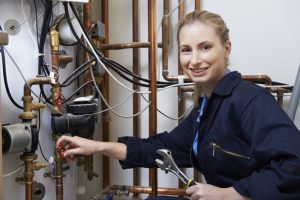The history of HVAC is a fascinating journey that spans centuries, evolving from early attempts to control indoor climates to the sophisticated systems we rely on today. Let’s explore this evolution, highlighting key milestones that have shaped modern comfort.
When searching for an HVAC contractor in Waukee, it’s important to consider their knowledge of HVAC advancements and their commitment to energy-efficient solutions. Contractors who stay abreast of the latest HVAC technologies will ensure a comfortable and environmentally friendly home for years to come.
Ancient Innovations
The ancient Romans were pioneers in early climate control. They developed the hypocaust system, a network of tunnels and flues used to circulate warm air beneath the floors and walls of buildings.
Around the same period, the Chinese were using natural ventilation techniques and water-driven fans to cool their homes. These early methods laid the foundation for understanding airflow and its impact on indoor environments.
The Middle Ages to the 19th Century
During the Middle Ages, advancements in heating primarily involved improving fireplaces and chimneys. The introduction of cast iron stoves in the 16th century allowed for more efficient burning of wood and coal, leading to better heat distribution in homes.
The Industrial Revolution in the 18th and 19th centuries brought significant changes. The first steam heating systems were developed, utilizing boilers and radiators to distribute heat through pipes. This era also saw the invention of the thermoregulator by Cornelis Drebbel, an early attempt at automatic temperature control.
The Birth of Modern HVAC
In 1902, Willis Carrier invented the first modern air conditioning system. Carrier’s system was initially designed to control humidity in a printing plant, but it quickly found applications in various industries and eventually in residential buildings.
The Great Depression slowed HVAC advancements, but significant progress was made in the development of refrigeration technology. This period also saw the introduction of the first residential air conditioning units.
The widespread adoption of central air conditioning in the 1950s revolutionized indoor comfort, making climate control a standard feature in American homes.
Late 20th Century to Present
The energy crisis of the 1970s prompted a shift towards energy-efficient HVAC systems. Innovations included improved insulation, better sealing techniques, and the development of heat pumps, which could both heat and cool spaces more efficiently.
The late 20th and early 21st centuries saw the integration of digital technology into HVAC systems. Programmable thermostats, smart controls, and sensors allowed for precise temperature regulation and energy management.
Today, the focus is on sustainability and environmental impact. Advances in renewable energy sources, such as geothermal technology, are being integrated into HVAC systems. Additionally, eco-friendly refrigerants and energy-efficient designs are becoming standard in new installations.
The HVAC evolution is a testament to human ingenuity and the relentless pursuit of comfort and efficiency. From ancient hypocaust systems to modern smart HVAC technologies. As we look to the future, the emphasis on sustainability and smart technology promises to continue shaping the landscape of HVAC.
At Dalton Plumbing, Heating, Cooling, Electric and Fireplaces, Inc., your comfort is our promise! To set up an appointment in the Des Moines area, give us a call at the number above, email customerservice@daltonphc.com or schedule an appointment online.

